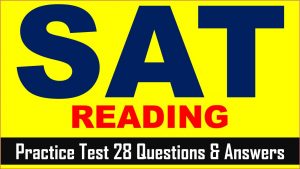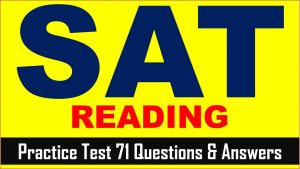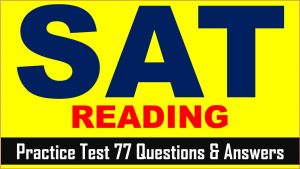SAT (Scholastic Assessment Test) is a standard test, used for taking admission to undergraduate programs of universities or colleges of the United States. SAT is developed and published by the College Board, an organization in the United States, administered by the Educational Testing Service. In this article of AKVTutorials, you will get Princeton SAT Prep Course Book Review | Practice Test 24 AMBiPi.
Princeton SAT Prep Course Book Review
According to the report, thousands of SAT qualifiers scores maximum in SAT test by reading Princeton Review SAT Book.
Check Price On Amazon
Now, is Princeton Review SAT Book best for SAT preparation after all of these track record and success rate of SAT candidates?
Yes or No.
Let’s review Princeton Review SAT Book in this article.
And, after reading this article, you will find that Princeton Review SAT Book is best for SAT exam or NOT.
Since this book has following points in the Princeton review book.
This book explains about the tactics to break the trap of SAT test paper.
Its example shows how to apply the strategies in solving the SAT questions.
This book has a lot of drills practice sections for each of the reading, writing and mathematics sections.
Its questions are according to same as real SAT paper
The more you take advantage of the Princeton Review for SAT Book we’ve included in this book and the online student tools that go with it, the better you’ll do on the test. Read the book carefully and learn our strategies.
Princeton review has following parts.
Part 1: Orientation
Part 2: How to Crack the Reading Test
Part 3: How to Crack the Writing and Language Test
Part 4: How to Crack the Math Test
Part 5: How to Crack the Essay
Part 6: Taking the SAT
Part 7: Practice Tests
Practice Test 1
Practice Test 2
Practice Test 3
Practice Test 4
SAT Reading Practice Passage
This passage is adapted from John Bohannon, “Why You Shouldn’t Trust Internet Comments.” ©2013 by American Association for the Advancement of Science.
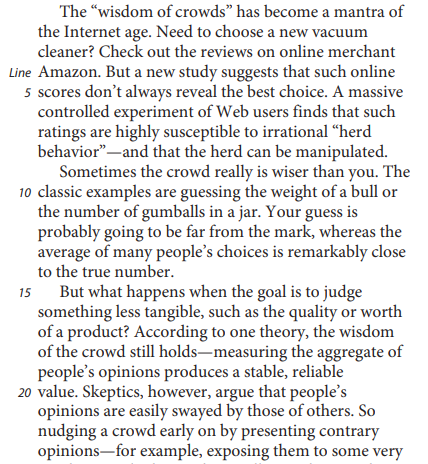
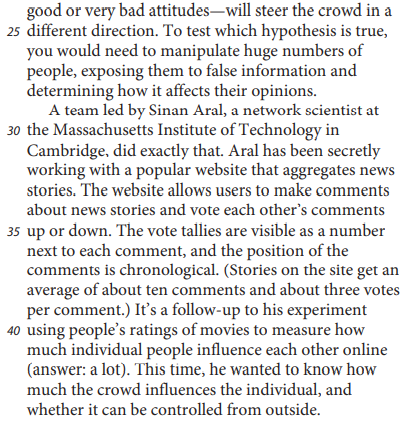
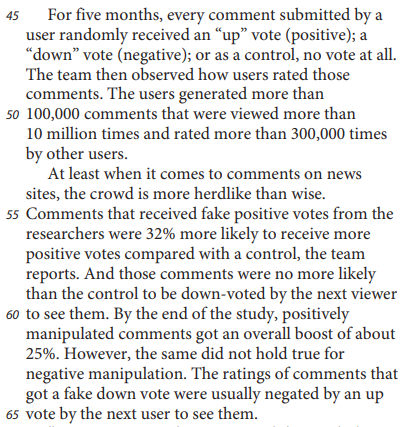
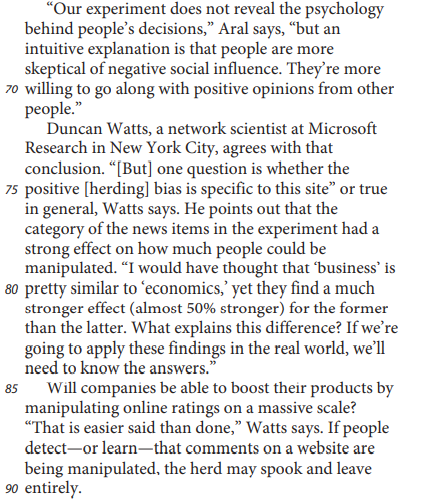
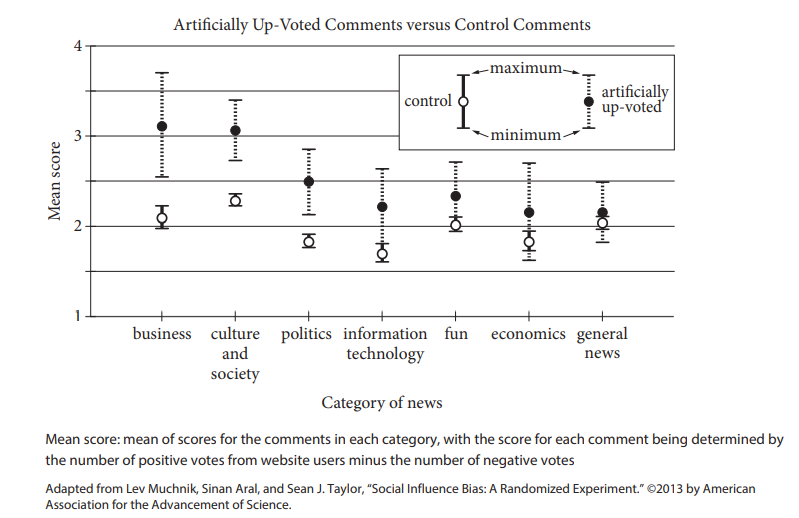
SAT Reading Comprehension Practice Test Questions
SAT Practice Test 24 Question No 1
Throughout the passage, the main focus shifts from a discussion of an experiment and its results to
Option A: an explanation of the practical applications of the results.
Option B: a consideration of the questions prompted by the results.
Option C: an analysis of the defects undermining the results.
Option D: a conversation with a scientist who disputes the results.
SAT Practice Test 24 Answer No 1
Show/Hide Answer
Option B :
The majority of the passage focuses on the experiment concerning “how much the crowd influences the individual, and whether it can be controlled from outside” (lines 42-44). After explaining the experiment and the results it produced, the passage moves on to consider questions raised by the results, such as whether the findings are site-specific or “true in general” (lines 75-76), why different findings are observed, and whether companies can “boost their products by manipulating online ratings on a massive scale” (lines 85-86).
Choice A is incorrect because the passage does not conclude by explaining the practical ways the experiment’s findings have been applied but rather by considering questions the findings raise. Choices C and D are incorrect because the passage does not indicate that there were any flaws in the experiment’s findings and does not include statements from anyone who disputes the findings.
SAT Practice Test 24 Question No 2
The author of the passage suggests that crowds may be more effective at
Option A: creating controversy than examining an issue in depth.
Option B: reinforcing members’ ideas than challenging those ideas.
Option C: arriving at accurate quantitative answers than producing valid qualitative judgments.
Option D: ranking others’ opinions than developing genuinely original positions.
SAT Practice Test 24 Answer No 2
Show/Hide Answer
Option C :
The author of the passage suggests that a group of people can be “wiser” and more effective than a single person at assessing a quantitative answer, or a measurement, versus producing a valid qualitative judgment, or a judgment of the quality of something. This is most clear in lines 11-14, which state that when guessing a bull’s weight or how many gumballs are in a jar, “your guess is probably going to be far from the mark, whereas the average of many people’s choices is remarkably close to the true number.”
Choices A, B, and D are incorrect because lines 11-14 indicate that the author believes that crowds may be more effective than individuals when arriving at quantitative answers rather than qualitative results. Nothing in the passage suggests that the author believes that crowds are better at starting disagreements than studying an issue in-depth (choice A), supporting ideas rather than challenging them (choice B), or ranking opinions rather than coming up with new ideas (choice D).
SAT Practice Test 24 Question No 3
Which choice provides the best evidence for the answer to the previous question?
Option A: Line 9 (“Sometimes… you”)
Option B: Lines 11-14 (“Your… number”)
Option C: Lines 17-20 (“According… value”)
Option D: Lines 25-28 (“To test… opinions”)
SAT Practice Test 24 Answer No 3
Show/Hide Answer
Option B :
The previous question asks what the author of the passage suggests about the wisdom of crowds, with the answer being that crowds can be more effective at producing quantitative answers than qualitative results. This is supported in lines 11-14: when it comes to guessing a bull’s weight or how many gumballs are in a jar, “your guess is probably going to be far from the mark, whereas the average of many people’s choices is remarkably close to the true number.”
Choices A, C, and D are incorrect because the lines cited do not support the answer to the previous question about the author’s belief about when the wisdom of a crowd is effective. Instead, they simply state that crowds are sometimes wiser than individuals, without explaining when (choice A), put forth a theory held by someone other than the author (choice C), and explain how hypotheses about the wisdom of crowds could be tested (choice D).
SAT Practice Test 24 Question No 4
Which choice best supports the view of the “skeptics” (line 20)?
Option A: Lines 55-58 (“Comments… reports”)
Option B: Lines 58-60 (“And… them”)
Option C: Lines 63-65 (“The ratings… them”)
Option D: Lines 76-79 (“He… manipulated”)
SAT Practice Test 24 Answer No 4
Show/Hide Answer
Option A :
In the passage, the author explains that those who are skeptical of the theory that “measuring the aggregate of people’s opinions produces a stable, reliable value” (lines 18-20) believe that “people’s opinions are easily swayed by those of others” (lines 20-21). This idea is best supported in lines 55-58, which describe a finding from a study of opinions in crowds: “Comments that received fake positive votes from the researchers were 32% more likely to receive more positive votes compared with a control, the team reports.” In other words, people were more likely to give a positive vote when they thought other people had given positive votes.
Choices B, C, and D are incorrect because the lines cited do not provide support for the skeptics’ idea that people’s opinions are easily influenced by the thoughts of others. Instead, they cite findings concerning people giving ratings different from those already given (choices B and C) and share an observation that the degree to which others can be influenced depends in part on the context of the situation (choice D).
SAT Practice Test 24 Question No 5
Which action would best address a question Watts raises about the study?
Option A: Providing fewer fake positive comments
Option B: Using multiple websites to collect ratings
Option C: Requiring users to register on the website before voting
Option D: Informing users that voting data are being analyzed
SAT Practice Test 24 Answer No 5
Show/Hide Answer
Option B :
One question Watts asks regarding the experiment is whether the results would hold on a larger scale. The passage quotes him in lines 74-76: “‘[But] one question is whether the positive [herding] bias is specific to this site’ or true in general.” Doing the experiment again but collecting ratings on multiple websites would address Watts’s question, as it would show whether or not the same results occur on other sites.
Choices A, C, and D are incorrect. Providing fewer fake positive comments during the experiment (choice A), requiring users to be registered on the website (choice C), or telling users that their answers will be studied (choice D) are actions that likely would affect the results of the experiment involving users voting on comments about stories on one news website, but they would not address Watts’s questions about whether the study would produce the same results on other websites or why different categories of news items had different effects on the news website.
SAT Practice Test 24 Question No 6
As used in line 85, “boost” most nearly means
Option A: increase.
Option B: accelerate.
Option C: promote.
Option D: protect.
SAT Practice Test 24 Answer No 6
Show/Hide Answer
Option C :
In lines 85-86 the author asks, “Will companies be able to boost their products by manipulating online ratings on a massive scale?” In the context of selling products by manipulating user reviews, “boost” most nearly means promote.
Choices A, B, and D are incorrect because, in the context of selling products by manipulating user reviews, the word “boost” refers to promoting the products, not making them larger or bigger (choice A), faster (choice B), or safe (choice D).
SAT Practice Test 24 Question No 7
As used in line 86, “scale” most nearly means
Option A: level.
Option B: wage.
Option C: interval.
Option D: scheme.
SAT Practice Test 24 Answer No 7
Show/Hide Answer
Option A :
In lines 85-86 the author asks, “Will companies be able to boost their products by manipulating online ratings on a massive scale?” In the context of selling products by manipulating user reviews on a massive scale, the word “scale” most nearly means level or size.
Choices B, C, and D are incorrect because, in the context of selling products by manipulating user reviews, a massive “scale” refers to a great level or size, not to a payment (choice B), an interval or space between things (choice C), or a plan (choice D).
SAT Practice Test 24 Question No 8
In the figure, which category of news has an artificially up-voted mean score of 2.5?
Option A: Business
Option B: Politics
Option C: Fun
Option D: General news
SAT Practice Test 24 Answer No 8
Show/Hide Answer
Option B :
The figure shows that while the mean score of the control comments in the politics category is below 2.0, the artificially up-voted mean score for that category is exactly 2.5.
Choice A is incorrect because the artificially up-voted mean score of comments in the business category is higher than 3.0. Choice C is incorrect because the artificially up-voted mean score of comments in the fun category is less than 2.5. Choice D is incorrect because the artificially up-voted mean score of the comments in the general news category is just over 2.0.
SAT Practice Test 24 Question No 9
According to the figure, which category of news showed the smallest difference in mean score between artificially up-voted comments and control comments?
Option A: Culture and Society
Option B: Information Technology
Option C: Fun
Option D: General News
SAT Practice Test 24 Answer No 9
Show/Hide Answer
Option D :
The figure shows that the mean score for both control comments and artificially up-voted comments in the general news category is just above 2.0.
Choice A is incorrect because the mean score for the control comments in the culture and society category is a little below 2.5 while the mean score for the artificially up-voted comments is over 3.0. Choice B is incorrect because the mean score for the control comments in the information technology category is a little above 1.5 while the mean score for the artificially up-voted comments is above 2.0. Choice C is incorrect because the mean score for the control comments in the fun category is exactly 2.0 while the mean score for the artificially up-voted comments is nearly 2.5.
SAT Practice Test 24 Question No 10
Data presented in the figure most directly support which idea from the passage?
Option A: The mean score of artificially down-voted comments is similar to that of the control.
Option B: The patterns observed in the experiment suggest that people are suspicious of negative social influence.
Option C: The positive bias observed in users of the news site may not apply to human behavior in other contexts.
Option D: The type of story being commented on has an impact on the degree to which people can be influenced.
SAT Practice Test 24 Answer No 10
Show/Hide Answer
Option D :
In the passage, Watts notes that “the category of the news items . . . had a strong effect on how much people could be manipulated” (lines 76-79). That idea is directly supported by the data in the figure, which show that the difference in mean score between the control comments and the artificially up-voted comments varies by subject (for example, in the general news category there is virtually no difference between the mean scores of the two types of comments, while for the business category there is almost a 1.0-point difference between the mean scores).
Choices A and B are incorrect because the passage provides no data for artificially down-voted comments or negative social influence. Choice C is incorrect because the figure applies only to one context (mean score of control comments versus a mean score of artificially up-voted comments on the news site); there is no way to tell what patterns would be observed in other contexts.



